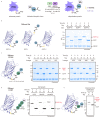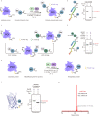Structure-guided engineering enables E3 ligase-free and versatile protein ubiquitination via UBE2E1
- PMID: 38341401
- PMCID: PMC10858943
- DOI: 10.1038/s41467-024-45635-y
Structure-guided engineering enables E3 ligase-free and versatile protein ubiquitination via UBE2E1
Abstract
Ubiquitination, catalyzed usually by a three-enzyme cascade (E1, E2, E3), regulates various eukaryotic cellular processes. E3 ligases are the most critical components of this catalytic cascade, determining both substrate specificity and polyubiquitination linkage specificity. Here, we reveal the mechanism of a naturally occurring E3-independent ubiquitination reaction of a unique human E2 enzyme UBE2E1 by solving the structure of UBE2E1 in complex with substrate SETDB1-derived peptide. Guided by this peptide sequence-dependent ubiquitination mechanism, we developed an E3-free enzymatic strategy SUE1 (sequence-dependent ubiquitination using UBE2E1) to efficiently generate ubiquitinated proteins with customized ubiquitinated sites, ubiquitin chain linkages and lengths. Notably, this strategy can also be used to generate site-specific branched ubiquitin chains or even NEDD8-modified proteins. Our work not only deepens the understanding of how an E3-free substrate ubiquitination reaction occurs in human cells, but also provides a practical approach for obtaining ubiquitinated proteins to dissect the biochemical functions of ubiquitination.
© 2024. The Author(s).
Conflict of interest statement
The authors declare no competing interests.
Figures






Similar articles
-
E3 ubiquitin-protein ligase TRIM21-mediated lysine capture by UBE2E1 reveals substrate-targeting mode of a ubiquitin-conjugating E2.J Biol Chem. 2019 Jul 26;294(30):11404-11419. doi: 10.1074/jbc.RA119.008485. Epub 2019 Jun 3. J Biol Chem. 2019. PMID: 31160341 Free PMC article.
-
Dual-color pulse-chase ubiquitination assays to simultaneously monitor substrate priming and extension.Methods Enzymol. 2019;618:29-48. doi: 10.1016/bs.mie.2019.01.004. Epub 2019 Feb 11. Methods Enzymol. 2019. PMID: 30850057
-
Regulation of canonical Wnt signalling by the ciliopathy protein MKS1 and the E2 ubiquitin-conjugating enzyme UBE2E1.Elife. 2022 Feb 16;11:e57593. doi: 10.7554/eLife.57593. Elife. 2022. PMID: 35170427 Free PMC article.
-
Structural Diversity of Ubiquitin E3 Ligase.Molecules. 2021 Nov 4;26(21):6682. doi: 10.3390/molecules26216682. Molecules. 2021. PMID: 34771091 Free PMC article. Review.
-
Neglected PTM in animal adipogenesis: E3-mediated ubiquitination.Gene. 2023 Aug 20;878:147574. doi: 10.1016/j.gene.2023.147574. Epub 2023 Jun 17. Gene. 2023. PMID: 37336271 Review.
Cited by
-
Advances in the chemical synthesis of human proteoforms.Sci China Life Sci. 2025 Sep;68(9):2515-2549. doi: 10.1007/s11427-024-2860-5. Epub 2025 Apr 8. Sci China Life Sci. 2025. PMID: 40210795 Review.
-
Chemical Synthesis of Human Proteoforms and Application in Biomedicine.ACS Cent Sci. 2024 Jul 22;10(8):1442-1459. doi: 10.1021/acscentsci.4c00642. eCollection 2024 Aug 28. ACS Cent Sci. 2024. PMID: 39220697 Free PMC article. Review.
-
Structural visualization of HECT-type E3 ligase Ufd4 accepting and transferring ubiquitin to form K29/K48-branched polyubiquitination.Nat Commun. 2025 May 9;16(1):4313. doi: 10.1038/s41467-025-59569-6. Nat Commun. 2025. PMID: 40341121 Free PMC article.
-
Combinatorial ubiquitin code degrades deubiquitylation-protected substrates.Nat Commun. 2025 Mar 24;16(1):2496. doi: 10.1038/s41467-025-57873-9. Nat Commun. 2025. PMID: 40128189 Free PMC article.
-
The autocrine motility factor receptor delays the pathological progression of Alzheimer's disease via regulating the ubiquitination-mediated degradation of APP.Alzheimers Res Ther. 2025 Apr 29;17(1):95. doi: 10.1186/s13195-025-01741-7. Alzheimers Res Ther. 2025. PMID: 40301979 Free PMC article.
References
MeSH terms
Substances
LinkOut - more resources
Full Text Sources
Research Materials
Miscellaneous

